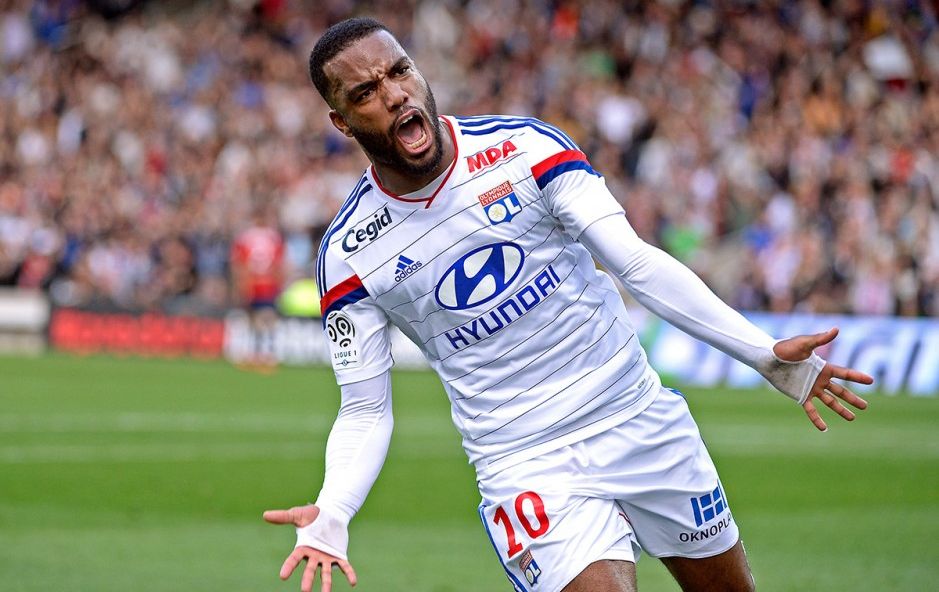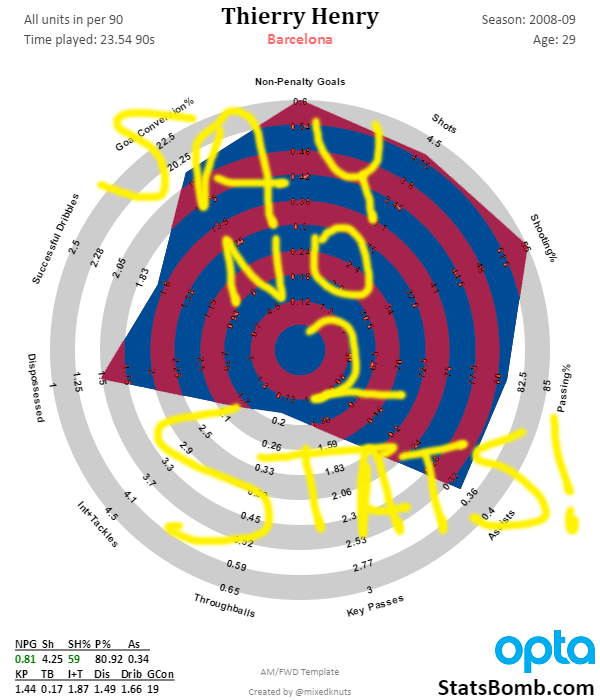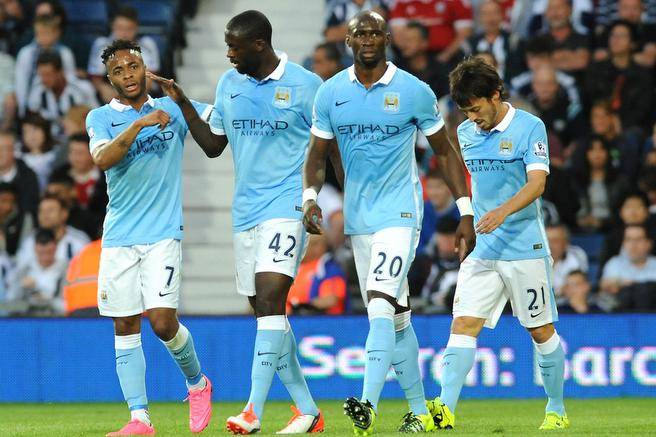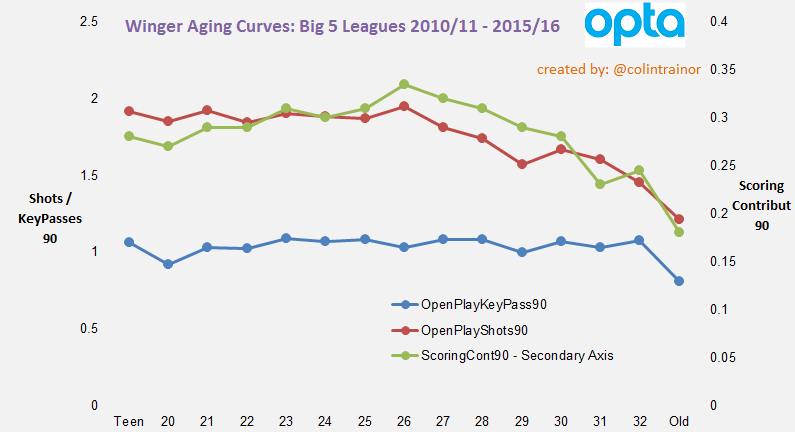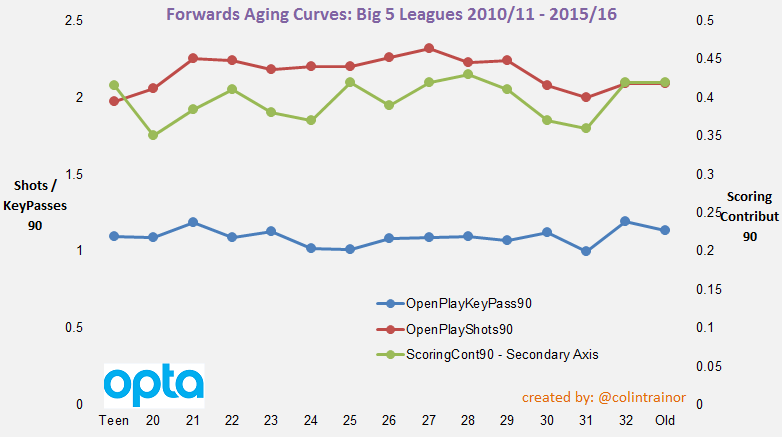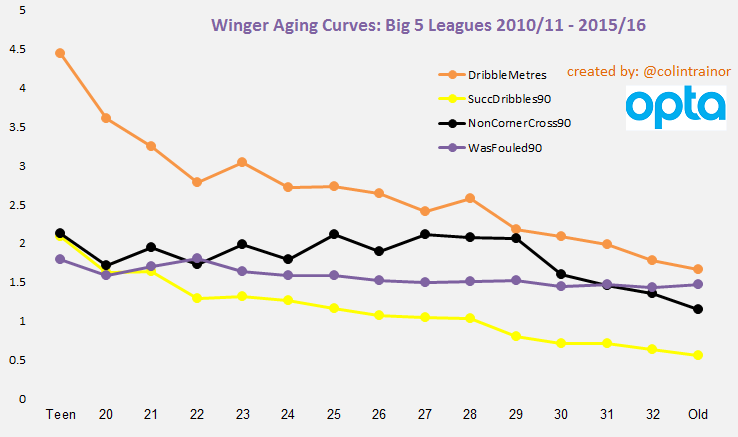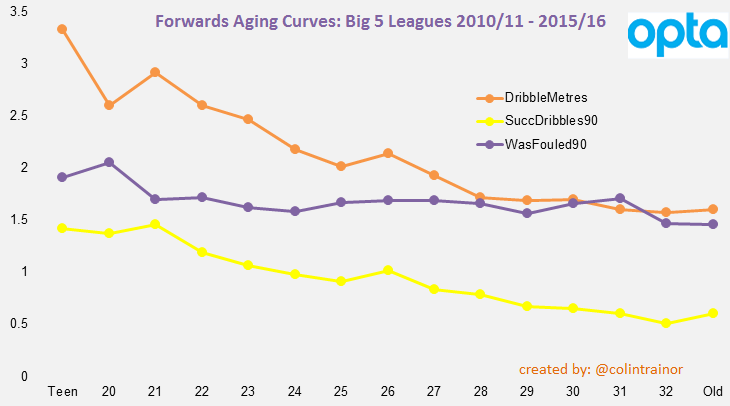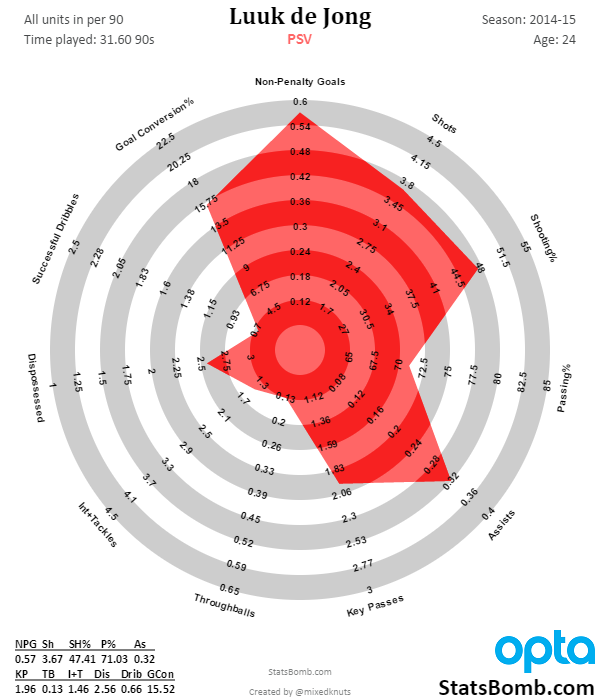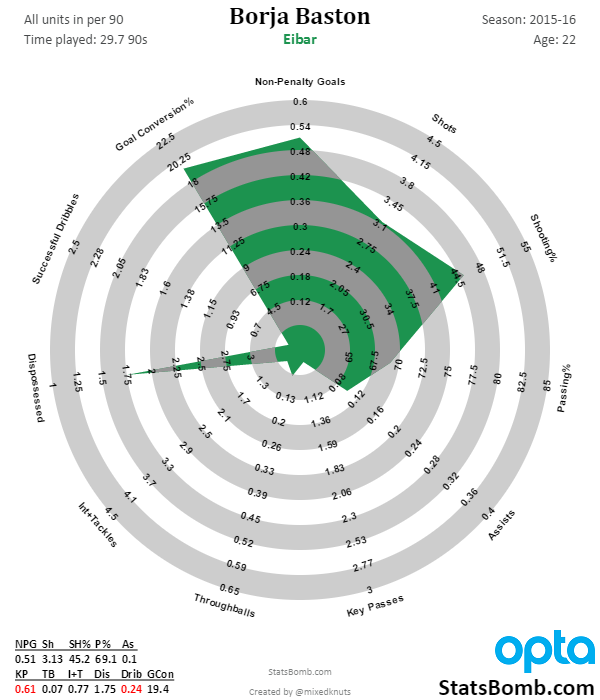Since his 27 goal explosion in 2014-15, Alexandre Lacazette has been linked with numerous big clubs over a move from Olympique Lyonnais, with the latest being Arsenal. Similar to Thierry Henry insofar as he started as a winger and later transitioned into a striker role, with the alleged dearth of top class strikers seemingly available he's been on the high on the list for big name clubs who need goal scoring reinforcements. Only Zlatan Ibrahimovic has scored more goals over the past three seasons in Ligue 1 than Lacazette, and he's been one of the starring members of Lyon's rise back to being a force in French football. It's been a quick ascension for the Lyon man and before Lacazette and Ibrahimovic, the last player to score 27 or more goals in a Ligue 1 season was Jean-Pierre Papin in 1991-92.
Scoring Data
Of course what will stand out with Lacazette's resume over the past three seasons was 2014-15. The general football media tends to judge strikers on their goal output and a 0.9 goals per 90 minutes rate is a fantastic return in a top 5 league, especially playing on a team that isn't full of star players. The problem though with judging strikers on goals even when standardized to a per 90 rate, is that penalties can inflate the total and Lacazette in 14-15 was a prime example. 27 goals look super impressive, but 8 of them were penalties which carry a near 80% conversion rate. Focusing only on his non penalty goals and his goal scoring rate drops to 0.6, which is still good and Ted Knutson a couple of years ago made a scale on where strikers were bracketed in terms of their NPG rate during the season. It's still a nice little reminder to this day when looking at a striker's production:
A fairly simple guideline for non-penalty scoring rates as a Forward is as follows:
.40 to .49 non-penalty goals per 90: Good.
.50 to .59 non-penalty goals per 90: Very good.
.60 to .79 non-penalty goals per 90: Probable Top 20 in Europe
.80 or above non-penalty goals per 90: Probable Top 5 in Europe
By that simple criteria, Lacazette's goal scoring season was top 20 caliber. Another thing to monitor is the quality of chances they're generating, which is why expected goals has had so much fanfare. Of course it isn't perfect as no single metric is, but by far it's the best way currently to examine shot quality on both a player and team level. Here are Lacazette's xG numbers along with his shot plot for all non penalty shots. (credit goes to @SteMc74 for the data and shot charts)

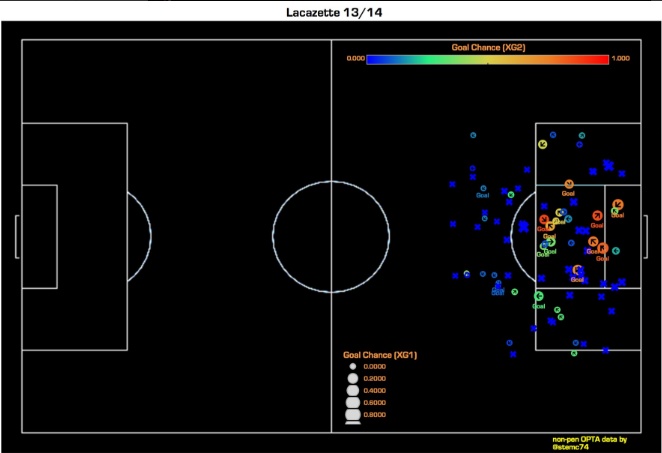
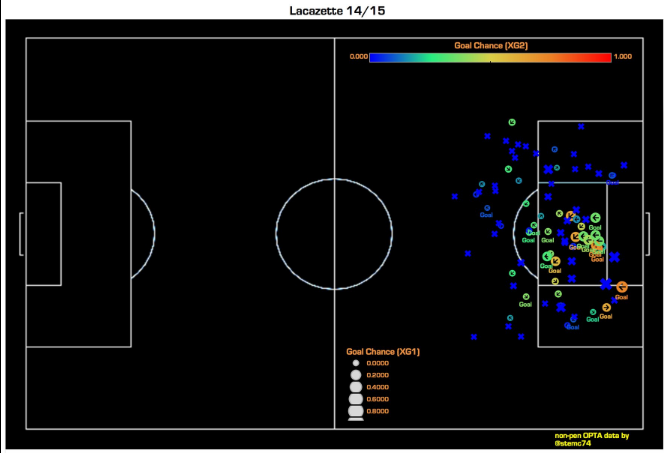
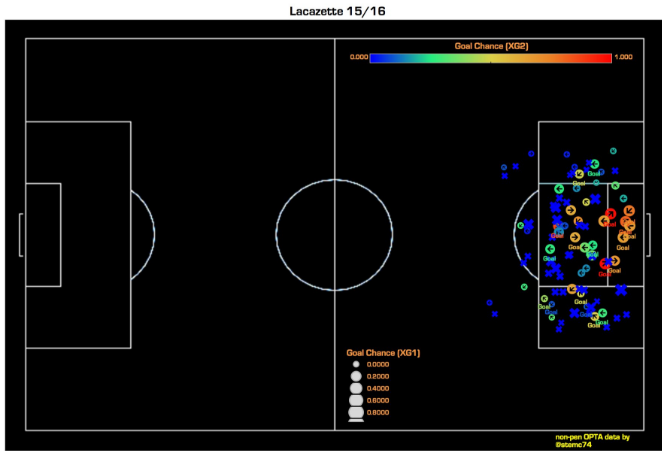
You can see a clear change from where he was in 2014 to where he is now, a change that ties in nicely with how Arsenal play football. The volume of long range shots that carry low goal probabilities have been replaced with poacher like opportunities instead. It's also important to note that since becoming a central player he has over performed xG numbers every single season and has posted a non penalty conversion rate between 18-22%. The degree to which he beat them the first two seasons were never going to be replicated but there is enough evidence to present an argument that Lacazette is an above average finisher. In fairness he also has played in Ligue 1 which isn't renown for sturdy goalkeeping so perhaps that helps a bit too. Regardless, his finishing ability might bypass some concerns about his shot volume not being quite up to a stellar level.
13-14
This was Lacazette's first season playing mainly as a central player, often playing as a second striker of sorts next to Bafetimbi Gomis. Watching Lacazette at this time and you can see both the initial promise of what he would eventually become and the struggles of honing down a new position. There were games during the season where Lacazette played as an inside winger on either side of the flank, particularly when Lyon switched into a 4-3-3 shape whenever Jimmy Briand was on the pitch, but these instances were rather infrequent. Lyon even experimented with a 4-2-3-1 formation without Gomis versus Nice in the beginning games of the season where Lacazette a lot of times did play as the lone forward despite being listed as a RW.
Lyon weren't a particularly good offensive team in 2013-14. They only scored 56 goals on the season which while ranking 4th in Ligue 1 is still a pedestrian output. Despite taking the 5th most shots in the league, their xG numbers were pretty poor too at only 1.09 per game. Watching Lyon's buildup play and you can see why that's the case, especially when it came to Lacazette trying to navigate playing with a more traditional striker. There would be numerous times where Lacazette would call for the ball to be played to his feet so he could run at defenders with speed, only for that pass to not be selected and instead shifted out to the fullbacks.
The end result a lot of times would be a cross intended for someone like Gomis to get on the end of it, a low percentage chance at best. Whenever Lacazette did get the ball, the quick hitting 1-2 combinations rarely materialized, often it'd just be a pass back to someone like Clement Grenier and the tempo would stall. It can be argued that the side was more tailored towards Gomis and Grenier while Lacazette was just there as a secondary figure. Lacazette had a tendency whenever Gomis was occupying the middle to shift out to a wide position and just stand there with little movement. On occasion Lacazette would gather the ball from the left wing on a fast moving attack and his first extinct would be to find Gomis with a cutback pass.
Having said all that, there were moments where you could see the type of close control and body shifting that would make him the key figure at Lyon in future years. The ability to shift and juke opponents in tight areas whether it be 45 yards from goal or just outside the penalty area were exquisite. Also for a guy who's listed at around 5'9, his lower body strength already was quite impressive as he could hold off defenders when receiving a ground pass with his back to goal.
Overall, given the circumstances both on the field and Lyon's financial difficulties in general, turning Lacazette into a striker was a victory for Lyon which would pay big dividends going forward.
14-15
The season that made Lacazette a household name featured a different cast of characters from the previous season. With Remi Garde departed, Hubert Fournier took over and Nabil Fekir and Clinton N'Jie became important members of the squad. Christophe Jallet was the everyday RB while Grenier and Gueida Fofana were injured for the majority of the season. Yoann Gourcuff was still there but in typical Gourcuff fashion, he played less than 1000 league minutes due to an assortment of injuries.
Perhaps the biggest change rebuilding the attack having seen Gomis move to Swansea. It allowed for Lyon to start playing Fekir in his spot instead which combined with Jallet's inclusion shifted the club to an even more ground based attack that incentivised cutbacks and discouraged long traditional crosses. This suited a striker like Lacazette and although the early results weren't quite there yet for Lyon it looked better than it did for major parts of the previous season.
There were games where Lacazette was held in check, notably in their matches against Olympique Marseille. The unorthodox man-to-man oriented press employed by Marcelo Bielsa disrupted Lyon's passing game, and thus made Lacazette more of a peripheral figure. While not employing the same pressing methods, similar results occurred versus PSG and Saint Etienne. The Marseille fixtures in particular were noteworthy because it forced Lyon to add a new wrinkle: to use fast moving counter attacks.
That new dedication to playing faster when the opportunities arose made Lacazette look like an irresistible force during numerous games. His hat-trick versus Lille, two goals against Caen and a host of other performances in the first half of the season profited from the added creativity around him paying huge dividends. This is the perfect illustration of how devastating Lyon were at time on the counter.
There were still lingering issues with Lacazette's play even with the gaudy goal totals. He struggled against teams with a low block defense in the 2nd half of the season and he was certainly running hot as evidenced by vastly outpacing xG numbers to that degree. Still, Lyon emerged as surprising contenders for the Ligue 1 title alongside Marseille, taking PSG to the final weeks of the season while getting themselves back into the Champions League group stage for the first time since 2011-12. Alongside Nabil Fekir, they emerged as the best forward duo in France that season and the future seemed bright. European football was on the horizon and a new stadium was to open in January 2016. Lyon could hope to rebuild back to their previous heights.
15-16
French football can take credit for the fact that they develop prospects relatively well. As a result their national team is stocked with future young talents for perhaps the next 10-12 years. One thing it isn't good with domestically is that as a result of finances, Ligue 1 clubs (bar PSG) have a pretty hard time keeping squads together for multiple seasons. One only has to look at what's happened to Marseille or Monaco over the past couple of summers and to see an illustration of that.
So it was a really big deal that Lyon kept the majority of their squad ahead of 2015-16. After the seasons they had, it would've been very easy for them to sell super high on Fekir and/ or Lacazette like they did with Clinton N'Jie. However Lyon inked numerous players to contract extensions, kept hold of the striker duo, and with their newfound finances they even added to the squad. Lyon bought Mathieu Valbuena, Sergi Darder, Claudio Beauvue in addition to other signings in an effort to have greater squad depth for juggling Ligue 1 and European Football. There were even hopes that Lyon could replicate their 2014-15 form and put another scare into PSG's domestic dominance.
However there were issues with that recruitment. Valbuena had been a good Ligue 1 player during his time at Marseille, but his fit at Lyon was at best questionable. His best gifts as a playmaker involved set piece deliveries and crosses from the halfspace towards a taller target, which didn't fit Lyon since Lacazette's transition to becoming the only traditional striker. In many ways he would have been a better fit on the Lyon sides of 2-3 years ago. Beauvue also had his issues trying to be the striking partner in the 4-4-2 diamond and settled so badly, he eventually ended up departing to Celta Vigo in January. You add those things together alongside the devastating knee injury to Fekir in early September, and you have a recipe for disaster which befell Lyon during the first half of the season. Lacazette suffered during this period too, most notably with back issues, and scored only 6 goals prior to the winter break including a hat-trick versus Saint Etienne.
Lyon made several changes during the winter break: they fired Fournier and hired Bruno Genesio as manager, switched to a 4-3-3 formation which allowed Rachid Ghezzal and Maxwel Cornet to emerge thus easing Valbuena off of the starting XI, and subsequently took off again: suring the second half of the season they were behind only PSG with the second most points and goal differential in Ligue 1. Fitness and form regained, it's here where we see the current and desirable version of Lacazette as a player:
- Version 1.0: A young second striker learning the ropes with clear talents but settling for impatient shots
- Version 2.0: A counter attacking machine with more nuance to his game but struggles still against certain defenses.
- Version 3.0: A goal poacher with improved link up play + movements, less reliance on counter attacks to generate quality chances but still really good at it, and a much better sense of when and where to shoot.
Of his 21 Ligue 1 goals in 2015-16, none of them came from outside the box and many of them came from making straightforward runs or even snatching up rebounds. The art of the striker: being at the right place at the right time. Lacazette came full circle as a player with his hat-trick versus Monaco in week 37. Billed as the game to decide which club qualifies straight into the Champions League group stage, his three goals capped Lyon's 6-1 thrashing and were brutally efficient, a contrast to previous hat-tricks where the aesthetics were considerably higher.
It wasn't quite the season he imagined, and despite his goal scoring streak in the 2nd half it wasn't enough for him to make it to the Euro 16 France roster, but Lacazette's stock has still never been higher, and nor has his price tag, now thought to be in the £40M range.
Conclusion
Alexandre Lacazette has become a very good goal scoring striker who year after year has improved in noticeable ways, whether it be his general link up play or his ability to shoot from better areas. It's also helped that this rise has coincided with Lyon's improvement as a club offensively over the same duration span and a growing diversity in their attack. As the team has got better around him, it's helped spur his evolution as a striker from a inefficient shot taker to a ruthless finisher. There are some questions surrounding the quality of fit that he'd be to Arsenal, given obvious differences in style to Olivier Giroud or similar types, but it also should be said that Lyon have evolved in a way that somewhat resembles what Arsenal, which can be seen both visually and the in the growing centrality of their shot selection in the 18 yard box.
If we highlight concerns with Lacazette, his shot numbers over the past two seasons have plateaued around 3 shots per 90 minutes, which is fine but a way off the rates of the truly elite strikers in Europe, though maybe that can be partly explained by Ligue 1's slower pace as a league. Size could be a bit of an issue if he does go to the Premier League next season, though judging by the success of very recent Ligue 1 imports to England maybe that's really nothing to worry about. The Premier League hosts perhaps the best stable of goalkeepers in the world and it'll be a better barometer as to how good of a finisher Lacazette truly is. If his finishing skill is genuinely in a higher echelon, then the shot generation concerns will subdue.
But will he move? It's entirely possible that he'll spend another season at Lyon, their financial crisis is a thing of the past and while no one would confuse them for PSG, they can go back to the smart player trading that made them 7 time league champions during the 2000's and a perennial Champions League knockout stage participant. Whatever the future holds, and whichever team ends up with Alexandre Lacazette, they are looking at a 25 year old striker landing in his peak who has shown a consistently high goal output over three years. Arsenal missed out on Jamie Vardy, but can they afford to ignore their pressing need for striking reinforcements? Reports today suggest Lacazette is keen to leave and he could well be the answer for Arsenal.
Someone tell Arsene.
